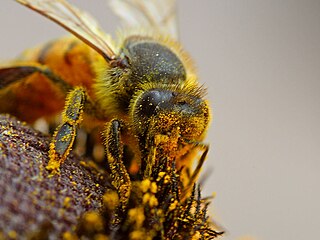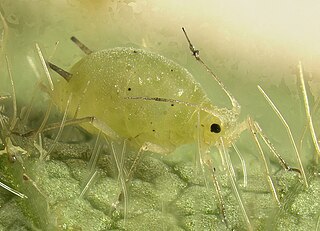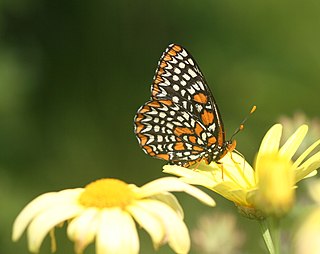 W
WInsect ecology is the scientific study of how insects, individually or as a community, interact with the surrounding environment or ecosystem.
 W
WAn alate refers to a winged reproductive caste from a social insect colony in its winged form. Their common behavioural function is starting a new colony, to expand their mother colonies etc. Colonies of termites and ants produce alates. It is a flight-based form of reproductive technique.
 W
WAn ant colony is the basic unit around which ants organize their lifecycle. Ant colonies are eusocial, and are very much like those found in other social Hymenoptera, though the various groups of these developed sociality independently through convergent evolution. The typical colony consists of one or more egg-laying queens, numerous sterile females and, seasonally, many winged sexual males and females. In order to establish new colonies, ants undertake flights that occur at species-characteristic times of the day. Swarms of the winged sexuals depart the nest in search of other nests. The males die shortly thereafter, along with most of the females. A small percentage of the females survive to initiate new nests.
 W
WAnt–fungus mutualism is a symbiosis seen in certain ant and fungal species, in which ants actively cultivate fungus much like humans farm crops as a food source. In some species, the ants and fungi are dependent on each other for survival. The leafcutter ant is a well-known example of this symbiosis. A mutualism with fungi is also noted in some species of termites in Africa.
 W
WAnthecology, or pollination biology, is the study of pollination as well as the relationships between flowers and their pollinators. Floral biology is a bigger field that includes these studies. Most flowering plants, or angiosperms, are pollinated by animals, and especially by insects. The major flower-frequenting insect taxa include beetles, flies, wasps, bees, ants, thrips, butterflies, and moths. Insects carry out pollination when visiting flowers to obtain nectar or pollen, to prey on other species, or when pseudo-copulating with insect-mimicking flowers such as orchids. Pollination-related interactions between plants and insects are considered mutualistic, and the relationships between plants and their pollinators have likely led to increased diversity of both angiosperms and the animals that pollinate them.
 W
WBee pollen is a ball or pellet of field-gathered flower pollen packed by worker honeybees, and used as the primary food source for the hive. It consists of simple sugars, protein, minerals and vitamins, fatty acids, and a small percentage of other components. Also called bee bread, or ambrosia, it is stored in brood cells, mixed with saliva, and sealed with a drop of honey. Bee pollen is harvested as food for humans and marketed as having various, but unproven, health benefits.
 W
WInsect biodiversity accounts for a large proportion of all biodiversity on the planet—over half of the estimated 1.5 million organism species described are classified as insects.
 W
WBombykol is a pheromone released by the female silkworm moth to attract mates. It is also the sex pheromone in the wild silk moth. Discovered by Adolf Butenandt in 1959, it was the first pheromone to be characterized chemically.
 W
WCembrene A, or sometimes neocembrene, is a natural monocyclic diterpene isolated from corals of the genus Nephthea. It is a colorless oil with a faint wax-like odor.
 W
WSeveral studies report a substantial decline in insect populations. Most commonly, the declines involve reductions in abundance, though in some cases entire species are going extinct. The declines are far from uniform. In some localities, there have been reports of increases in overall insect population, and some types of insects appear to be increasing in abundance across the world. A 2020 meta-analysis published in the journal Science found that globally, terrestrial insects appeared to be declining in abundance at a rate of about 9% per decade, while the abundance of freshwater insects has increased by 11% per decade.
 W
WElaiosomes are fleshy structures that are attached to the seeds of many plant species. The elaiosome is rich in lipids and proteins, and may be variously shaped. Many plants have elaiosomes that attract ants, which take the seed to their nest and feed the elaiosome to their larvae. After the larvae have consumed the elaiosome, the ants take the seed to their waste disposal area, which is rich in nutrients from the ant frass and dead bodies, where the seeds germinate. This type of seed dispersal is termed myrmecochory from the Greek "ant" (myrmex) and "circular dance" (khoreíā). This type of symbiotic relationship appears to be mutualistic, more specifically dispersive mutualism according to Ricklefs, R.E. (2001), as the plant benefits because its seeds are dispersed to favorable germination sites, and also because it is planted by the ants.
 W
WAn entomopathogenic fungus is a fungus that can act as a parasite of insects and kills or seriously disables them.
 W
WEntomophily or insect pollination is a form of pollination whereby pollen of plants, especially but not only of flowering plants, is distributed by insects. Flowers pollinated by insects typically advertise themselves with bright colours, sometimes with conspicuous patterns leading to rewards of pollen and nectar; they may also have an attractive scent which in some cases mimics insect pheromones. Insect pollinators such as bees have adaptations for their role, such as lapping or sucking mouthparts to take in nectar, and in some species also pollen baskets on their hind legs. This required the coevolution of insects and flowering plants in the development of pollination behaviour by the insects and pollination mechanisms by the flowers, benefiting both groups.
 W
WThe fecal shield is a structure formed by the larvae of many species of beetles in the leaf beetle family, Chrysomelidae. It is composed of the frass of the insect and often its exuviae, or bits of shed exoskeleton. The beetle may carry the shield on its back or wield it upon its posterior end. The main function of the fecal shield is defense against predators. Other terms for the fecal shield noted in the literature include "larval clothing", "kotanhang", "faecal mask", "faecal pad", and "exuvio-faecal annex".
 W
WFrass refers loosely to the more or less solid excreta of insects, and to certain other related matter.
 W
WThe gyne is the primary reproductive female caste of social insects. Gynes are those destined to become queens, whereas female workers are typically sterile and cannot become queens. A colony with multiple queens is said to be a polygyne form, whereas with only one is a monogyne form.
 W
Wcis-3-Hexenal, also known as (Z)-3-hexenal and leaf aldehyde, is a colorless liquid and an aroma compound with an intense odor of freshly cut grass and leaves. It is one of the major volatile compounds in ripe tomatoes. It is produced in small amounts by most plants and it acts as an attractant to many predatory insects. It is also a pheromone in many insect species.
Insectary plants are those that attract insects. As such, beneficial insectary plants are intentionally introduced into an ecosystem to increase pollen and nectar resources required by the natural enemies of harmful or unwanted insect pests. Beyond an effective natural control of pests, the beneficial insects also assist in pollination.
 W
WAn insectivore is a carnivorous plant or animal that eats insects. An alternative term is entomophage, which also refers to the human practice of eating insects.
 W
WIn biology, a lerp is a structure of crystallized honeydew produced by larvae of psyllid bugs as a protective cover. These animals are commonly referred to as lerp insects.
 W
WMyrmecochory is seed dispersal by ants, an ecologically significant ant-plant interaction with worldwide distribution. Most myrmecochorous plants produce seeds with elaiosomes, a term encompassing various external appendages or "food bodies" rich in lipids, amino acids, or other nutrients that are attractive to ants. The seed with its attached elaiosome is collectively known as a diaspore. Seed dispersal by ants is typically accomplished when foraging workers carry diaspores back to the ant colony, after which the elaiosome is removed or fed directly to ant larvae. Once the elaiosome is consumed, the seed is usually discarded in underground middens or ejected from the nest. Although diaspores are seldom distributed far from the parent plant, myrmecochores also benefit from this predominantly mutualistic interaction through dispersal to favourable locations for germination, as well as escape from seed predation.
 W
WNectar is a sugar-rich liquid produced by plants in glands called nectaries or nectarines, either within the flowers with which it attracts pollinating animals, or by extrafloral nectaries, which provide a nutrient source to animal mutualists, which in turn provide herbivore protection. Common nectar-consuming pollinators include mosquitoes, hoverflies, wasps, bees, butterflies and moths, hummingbirds, honeyeaters and bats. Nectar plays a crucial role in the foraging economics and evolution of nectar-eating species; for example, nectar foraging behavior is largely responsible for the divergent evolution of the African honey bee, A. m. scutellata and the western honey bee.
 W
WNuptial flight is an important phase in the reproduction of most ant, termite, and some bee species. It is also observed in some fly species, such as Rhamphomyia longicauda.
 W
WOleic acid is a fatty acid that occurs naturally in various animal and vegetable fats and oils. It is an odorless, colorless oil, although commercial samples may be yellowish. In chemical terms, oleic acid is classified as a monounsaturated omega-9 fatty acid, abbreviated with a lipid number of 18:1 cis-9. It has the formula CH3(CH2)7CH=CH(CH2)7COOH. The name derives from the Latin word oleum, which means oil. It is the most common fatty acid in nature. The salts and esters of oleic acid are called oleates.
 W
WPearl bodies are small, lustrous, pearl-like food bodies produced from the epidermis of leaves, petioles and shoots of certain plants. They are rich in lipids, proteins and carbohydrates, and are sought after by various arthropods and ants, that carry out vigorous protection of the plant against herbivores, thus functioning as a biotic defence. They are globose or club-shaped on short peduncles, easily detached from the plant, and are food sources in the same sense as Beltian bodies, Müllerian bodies, Beccarian bodies, coccid secretions and nectaries. They occur in at least 19 plant families (1982) with tropical and subtropical distribution.
 W
WThe population dynamics of pest insects is a subject of interest to farmers, agricultural economists, ecologists, and those concerned with animal welfare.
 W
WA pheromone trap is a type of insect trap that uses pheromones to lure insects. Sex pheromones and aggregating pheromones are the most common types used. A pheromone-impregnated lure, as the red rubber septa in the picture, is encased in a conventional trap such as a bottle trap, Delta trap, water-pan trap, or funnel trap. Pheromone traps are used both to count insect populations by sampling, and to trap pests such as clothes moths to destroy them.
 W
WPollination syndromes are suites of flower traits that have evolved in response to natural selection imposed by different pollen vectors, which can be abiotic or biotic, such as birds, bees, flies, and so forth. These trait includes flower shape, size, colour, odour, reward type and amount, nectar composition, timing of flowering, etc. For example, tubular red flowers with copious nectar often attract birds; foul smelling flowers attract carrion flies or beetles, etc.
 W
WA pollinator is an animal that moves pollen from the male anther of a flower to the female stigma of a flower. This helps to bring about fertilization of the ovules in the flower by the male gametes from the pollen grains.
 W
WFeeding is the process by which organisms, typically animals, obtain food. Terminology often uses either the suffixes -vore, -vory, or -vorous from Latin vorare, meaning "to devour", or -phage, -phagy, or -phagous from Greek φαγεῖν, meaning "to eat".
 W
WTrophallaxis is the transfer of food or other fluids among members of a community through mouth-to-mouth (stomodeal) or anus-to-mouth (proctodeal) feeding. Along with nutrients, trophallaxis can involve the transfer of molecules such as pheromones, organisms such as symbionts, and information to serve as a form of communication. Trophallaxis is used by some birds, gray wolves, vampire bats, and is most highly developed in social insects such as ants, wasps, bees, and termites.
 W
WThe term woodboring beetle encompasses many species and families of beetles whose larval or adult forms eat and destroy wood. In the woodworking industry, larval stages of some are sometimes referred to as woodworms. The three most speciose families of woodboring beetles are longhorn beetles, bark beetles and weevils, and metallic flat-headed borers.
 W
W